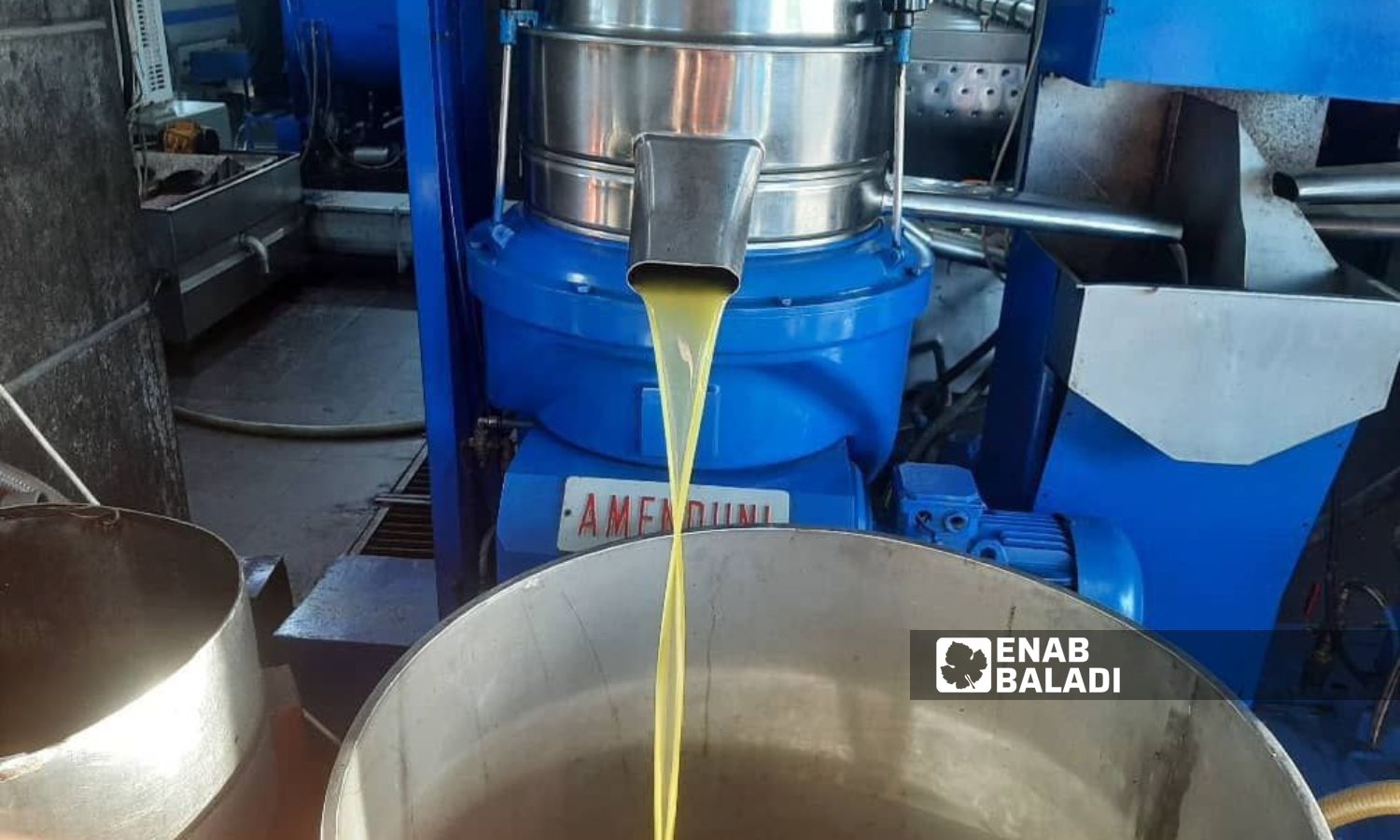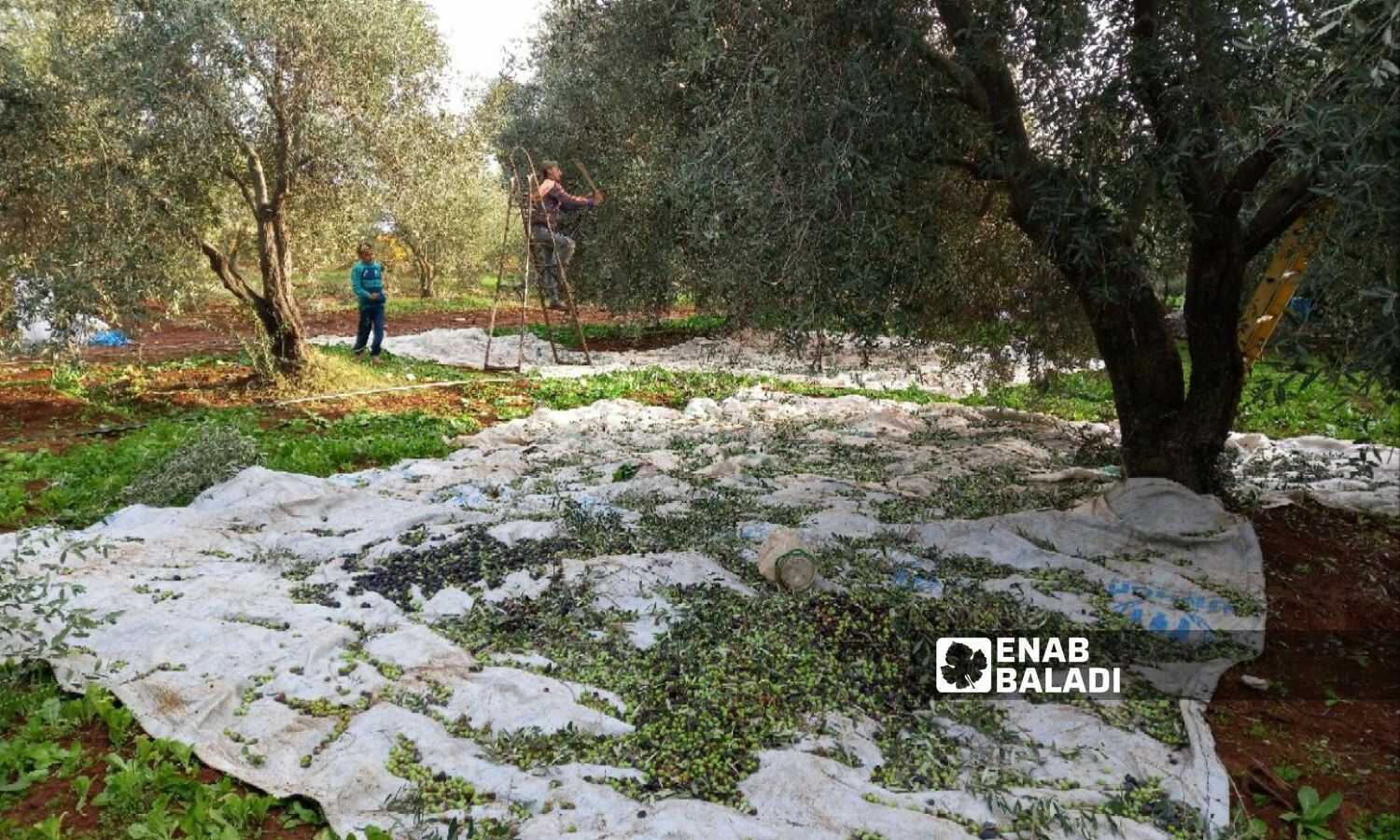



Faiza al-Saeed was not able to buy more than one tin can of olive oil worth one million Syrian pounds, which she bought in the olive pressing season, in November 2023.
Olive oil prices have been rising gradually and reached 1.4 million Syrian pounds in the local market in Daraa province, southern Syria, as monitored by Enab Baladi.
Al-Saeed, a housewife from rural Daraa, explained that the prices of oil exceeded the family’s financial capacity, as she used to buy about five tin cans (16 liters) as an annual supply. However, due to difficult economic conditions, she had to buy in installments this time, after saving the price from the work of her children and husband, as she detailed to Enab Baladi.
Meanwhile, Intisar Abdel Hamid, another housewife, did not buy olive oil for her family because they could not afford it. It was part of a tradition in the province where households would buy oil directly from presses or farmers during the pressing season, as prices increase after the season that ended in mid-January of this year.
Abdel Hamid stated that the prices have changed and become unaffordable, pointing out that she purchased a tin can of olive oil during the pressing season of 2022 for 275,000 Syrian pounds, before the price rose to about five times what it was.
The prices of olive oil have been climbing in Daraa for over a year, particularly after the Syrian regime’s government allowed the export of 45,000 tons of olive oil in October 2022, justifying the decision by the expected Syrian production of about 125,000 tons, and that the quantities approved for export were surplus production.

Olive pressing process in the western countryside of Daraa – October 27, 2023 (Enab Baladi/Halim Muhammad)
In September 2023, olive oil prices reached about 800,000 Syrian pounds as traders began to withdraw the commodity from the market in preparation for raising its price.
In August 2023, the regime’s government issued a decision to halt the export of olive oil as of the beginning of September of the same year, but the oil prices did not decrease.
Less than four months after the decision to halt oil exportation, the economic committee in the Syrian Presidency of the Council of Ministers allowed the export of olive oil again in December of the same year, provided that the oil is exported in containers not exceeding five liters, and that the exported quantities do not exceed 5,000 tons.
The director of the Olive Office in the Ministry of Agriculture, Abeer Jawhar, told the local Al-Watan newspaper on February 6, that the government permitted the export of part of the production so that Syria does not lose its position in the global market of olive oil production.
Al-Saeed resorts to economizing on the use of olive oil and compensates for the shortage by buying sunflower oil and mixing it with olive oil to save on consumption.
The price of a liter of sunflower oil reached 25,000 Syrian pounds, while the price of a liter of olive oil reached 87,500 Syrian pounds.
Mohammed Nahar (33 years old) turned to searching for olives in harvested fields, which is called “tafīr,” and said that he looks for the fruit under trees or what is left on the branches. He managed to collect nearly 100 kilograms over ten days, producing one tin can of olive oil.
He explained that he would not be able to buy oil for this year due to his financial inability, as he works on a daily wage of 20,000 Syrian pounds, which means he would need to work for two months to buy a tin can of olive oil.

Workers pressing olives in a mill in western Daraa countryside – October 27, 2023 (Enab Baladi/Halim Muhammad)
The proportion of oil production varies according to the type of trees, care, and age, since young trees produce differently from old ones.
According to the agricultural engineer Khaled Suleiman, some types of olives require larger quantities of fruit to produce oil, and these varieties are intended for table consumption, like the “Abu Shouka” and “Maouy” olives, which produce about one tin can of oil per 150 kilograms of fruit. In contrast, most fields produce about one tin can of oil per 100 kilograms of olives.
There are also types specially grown for oil production, like the Qaisi, Nabali, and Sorani varieties, and there are dual-purpose varieties suitable as table olives and also produce good oil yield, such as “Istanbuli” and “al-Dan” varieties.
The engineer clarified that the produce of home gardens is no different from that of fields, but the difference is made by the care for the trees, spraying the crops, fertilization, and irrigation.

Workers harvesting olive fruits from a field in the western countryside of Daraa – December 8, 2023 (Enab Baladi/Halim Muhammad)
Bassam al-Hashish, the director of agriculture in Daraa, stated in an interview with the state Al-Baath newspaper in November 2023, that there are 3.5 million olive trees in the province and that the production of olives reached 25,000 tons, 16,000 tons of which are designated for pressing. He pointed out that locally produced olive oil covers 40% of the province’s needs for oil.
According to the director of the Olive Office in the Ministry of Agriculture, the production estimates for this year amount to 91,000 tons across all of Syria. Part of the olives will be used for table consumption, and a larger portion will be pressed. Approximately 50% of this year’s production is located in areas outside the regime’s control.
if you think the article contain wrong information or you have additional details Send Correction